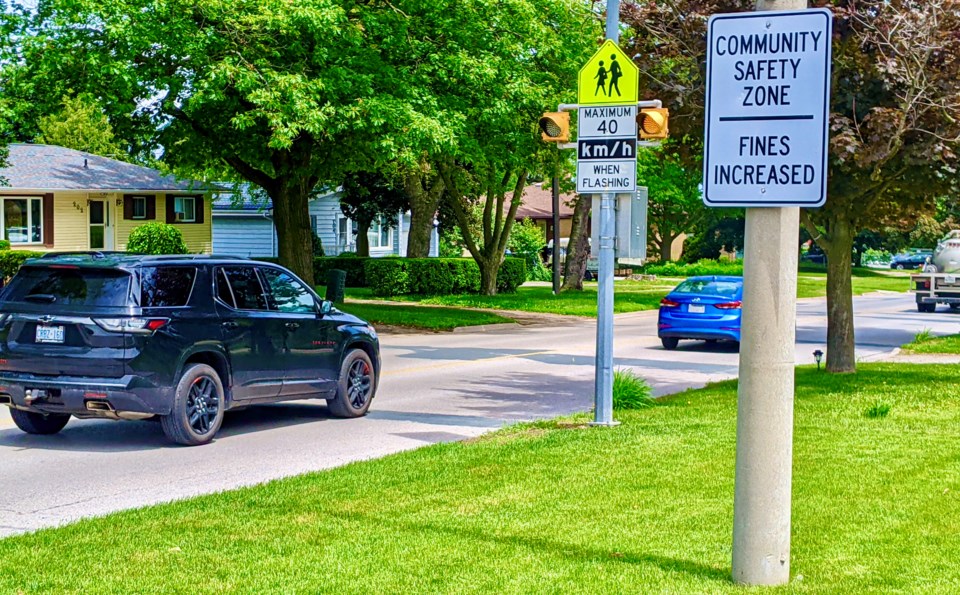Catching speeders in Barrie could be just a click away by year’s end.
Council approved a motion Monday night that city staff be authorized to move ahead with an automated speed enforcement (ASE) program in school zones and community safety zones, with a spending limit of $300,000 this year.
The plan is to lease two mobile cameras, report back on the cost and requirements of leasing two more cameras and give consideration to roads around high schools, not just elementary schools.
“The funds to set up the system are approved in this year's budget. It could be done as early as the end of the year,” said Coun. Clare Riepma. “The legislation requires a 90-day notice period, which means that even if we had everything ready to go today, it could not be operational before the school year starts.”
This program would involve rotating the mobile cameras throughout the city, hiring a new senior transportation technologist, Ontario Transportation Ministry (MTO) licence-plate hookup costs, Barrie’s portion of the shared costs associated with a joint processing centre or sworn provincial offences officers who review the camera images and issue tickets, traffic signs, postage, and startup membership costs.
“All of this will take some time,” Riepma said. “However, when the system is implemented, we expect driving behaviour in school zones to improve.”
ASE is a system that uses a camera and a speed measuring device to detect and capture images of vehicles travelling faster than the posted speed limit in school or community safety zones. These types of charges are the responsibility of the vehicle owner and not the driver. They must currently be processed through a Provincial Offences (POA) Court office.
The ticket contains a digitized copy of the image and an enlargement of the plate portion. It is mailed to the registered licence-plate holder within 30 days of the offence, outlining next steps and the cost of the associated fine. There is a monetary fine for those convicted, but demerit points are not issued and the registered owner’s driving record isn’t affected.
The staff report indicates this program could pay for itself, with two cameras, and any excess revenue could be used for further initiatives, such as more automated speed enforcement units, red-light cameras or traffic calming measures.
Once the ASE program is operational, city staff anticipate 880 violations per month — based on two camera locations and relocated between wards every two months.
Peter Leon, communications co-ordinator with Barrie Police Service (BPS), has said its traffic unit laid approximately 8,600 speeding tickets throughout the entire city last year. He said BPS supports initiatives that promote community and road safety. The city has already introduced traffic-calming measures, such as speed cushions and road diets, which means narrowing a street to slow down traffic.
City staff will also evaluate the feasibility of community safety zones adjacent to secondary schools with the variable flashing, 40 kilometre-per-hour sign upon council request, and report back.
School zones are designated road areas near a school, and typically occur within 150 metres of the front of a school and have reduced speed limits during specific periods of the day. City council policy mandates a 40-km/h posted speed limit in front of elementary schools, as well as for roadways where – due to their geometric design – there is an increased probability of danger when a car drives at 50 km/h or a higher speed limit.
On major roads where there are elementary schools, a ’40 km/h when flashing’ speed limit is in effect. Barrie has these speed limits – which follow varying time schedules – in 23 elementary school locations.
Community safety zones are established by municipal council through a bylaw, and cover road areas where there is a higher risk to, or concern for, drivers, pedestrians, cyclists and/or others who share the space. Highway Traffic Act fines, including speeding, are doubled in community safety zones and many community safety zones are located close to schools. Barrie has 81 sections of road designated as community safety zones in accordance with the community safety zones bylaw.
All will be eligible with council approval of the ASE program.



